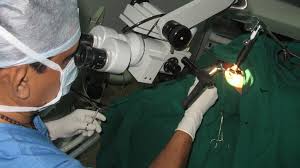

Microlaryngoscopy is a procedure in which the larynx is visualized through a microscope. It thus allows a magnified view of the larynx which is not possible on direct or indirect laryngoscopy.
Kleinsasser in 1960 introduced and popularised the new microlaryngoscope used in conjunction with the microscope. Indications: Diagnostic: 1) To have a microscopic visualization of the larynx in cases of hoarseness of voice which cannot be diagnosed by indirect or direct laryngoscopy. 2) Biopsy of laryngeal lesions. Also, the extent of the growth can be seen by this procedure. 3) For assessment of laryngeal trauma.al surgeries like tonsillectomy in adults, oral biopsies etc. 1) Removal of foreign bodies. 2) Excision of benign lesions like vocal cord polyps, cysts, haemangiomas and nodules. 3) Injection of teflon paste in the vocal cords in cases of vocal cord palsy. 4) Laser cordectomy in carcinoma of vocal cord. 5) Dilatation of subglottic stenosis. 6) Insertion of laryngeal stents. 7) Arytenoidectomy in cases of abductor cord palsy. 8) Can be used with CO2 Laser, Coblator, Radiofrequency or Microdebridor for Vocal cord lesions. 1) Patient is under general anaesthesia. 2) A smaller size than normal endotracheal tube is used. 3) The laryngoscope is held in the right hand and inserted into the oral cavity till the epiglottis is visualized. The tip of the epiglottis is lifted with the laryngoscope. The larynx is then visualized and the scope is fixed to the chest piece. 4) An operative binocular microscope with 400 mm lens helps in examination of the larynx under microscope. 5)The patient is in Boyce position with flexion of the cervical spine and extension of the atlanto-occipital joint. 1. Magnified binocular vision.
2. Both hands of the operating surgeon are free for carrying out the procedure. 3. Exact precision is achieved when performing laser or cryosurgery. 4. Video attachment to the microscope allows documentation and teaching. 1) Damage to lips, tongue, teeth and other surrounding structures.
2) Damage to cervical spine due to the Boyce position.
3) Manipulation of the larynx can cause vagal stimulation.
4) Anesthetic complications.
5) Complications of the laser.
History:
Therapeutic:


Technique:
Advantages of Microlaryngoscopy over direct laryngoscopy:
Complications
Book Your Appointment